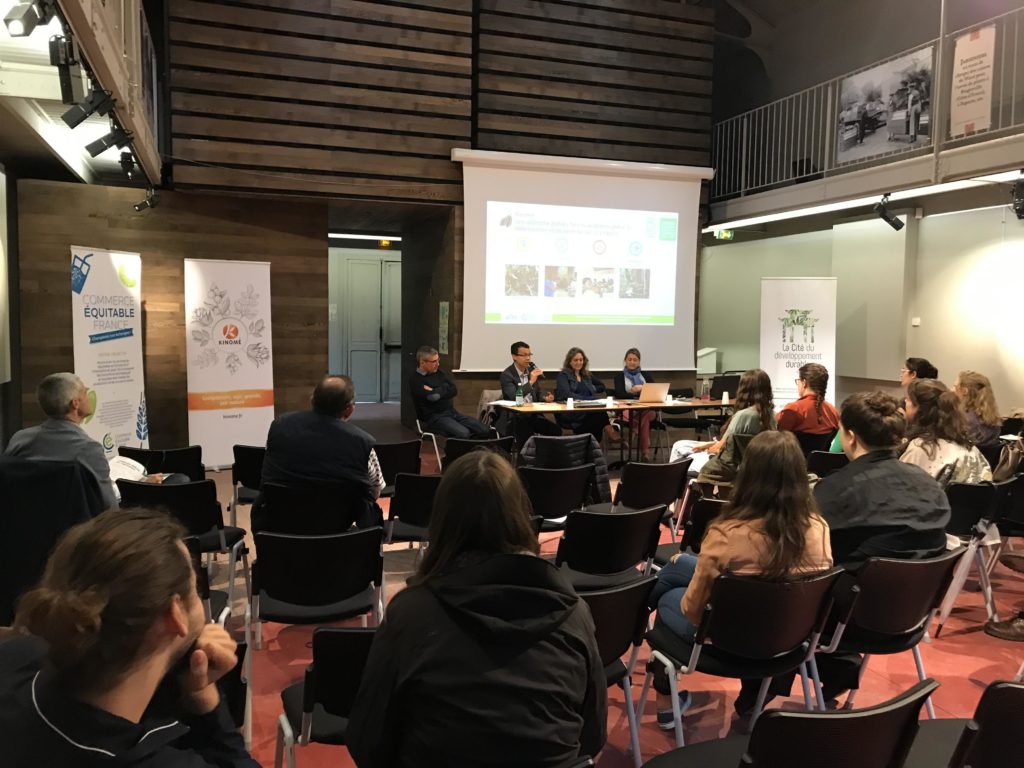

11.06.2019
As part of the Sustainable Development Week in France, a round table was held on June 5th at the Cité du Développement Durable, and brought together ATIBT, Fair Trade France, and Kinomé.
Our association took part in this round table, to continue to capitalize on the work done about agroforestry opportunities, and which was the subject of a communication a short time ago at the World Agroforestry Congress of Montpellier.

During this round table, Kinomé noted the difficulties regarding the development of cocoa, particularly regarding unsustainable practices. He highlighted that it is in everyone’s interest to have sustainable cocoa production, considering the constant evolution of its consumption worldwide.
In West Africa, a clear finding is made about the loss of forest cover in
close connection with the development of cocoa.
In Central Africa, the situation is quite
different because the forest cover remains important, but complementary
activities are necessary for the local communities and for the production of
exportable food, while allowing the diversification of the forest concessions
model.
Although agroforestry is not a panacea, it is a great opportunity because of the resilience that its model can provide. Climatologists predict a difficult future for the cocoa sector if nothing is done over the next few years. The conclusions at the Montpellier congress alerted the sector’s partners.
On the other hand, the forest world
is actually very close to the cocoa sector, and at a time when sustainable
management must be more than ever on the agenda, forest and cocoa can join.
In fact, the certified concessions model is
currently in difficulty, as the market does not make it sustainable. In this
context, agroforestry could be an opportunity
for the future to provide at the same time a diversification to certain concessions, an opportunity to supply timber but also other social and environmental services.
The forest and cocoa reconciliation is therefore necessary in each of the two cases, by « introducing the forest into cocoa plantations » for West Africa, or by « introducing cocoa into degraded forests » in the Congo Basin.
The cocoa-timber tree association is therefore a landscape approach that seems obvious and interesting for the different stakeholders of such a model.
This approach also makes it possible to find know-how in shaded cocoa farming, which has been somewhat forgotten while remaining largely valid.
Le Commerce Equitable France (Fair Trade France) mentioned a case developed in Côte d’Ivoire, where agroforestry is reintroduced. Some farmers’ organizations are initiating agroforestry experiments, as other organizations located in the Andean countries already done, to face social and environmental issues related to cocoa farming. The results are all the more promising as the yields are higher than the averages recorded in the peasant environment, the resistance to drought seems better and the survival rates of cocoa trees and trees are also very good. All these results are more noteworthy since the producer organizations are solid and well organized. In the case of Côte d’Ivoire, a cooperative (CAMAYE) has initiated a project with the Equity program that has several aims to (a) structure producer organizations, (b) Strengthen networks of actors and (c) Use the potential of fair trade.
Also in Côte d’Ivoire, another initiative was launched by Cémoi, namely the project « Cacao forest friend ». Tranchivoire, a member of ATIBT, has also launched activities to stimulate the development of cocoa under the shading of timber tree species.
The rapprochement of ATIBT with initiatives in the field of agroforestry has different aims:
Legal framework and land issues still have to be addressed, although in countries such as Côte d’Ivoire there have been recent developments. What seems obvious is that this thinking between different actors of the Cité du Développement Durable is timely given the recent initiatives to combat imported deforestation (French strategy against imported deforestation – SNDI), the obvious climatic problems in some countries like the Côte d ‘Ivoire, but also the difficult viability of the certified concession model.